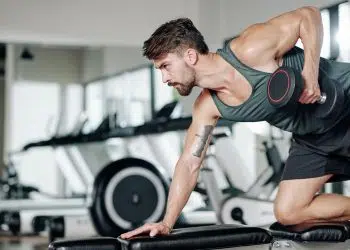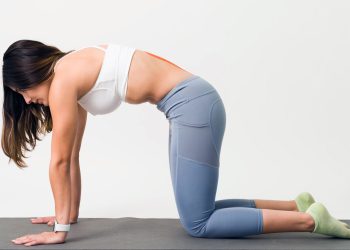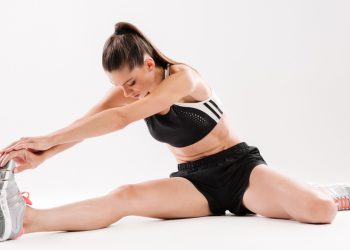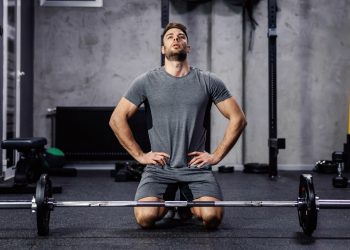Butt Kicks, also known as butt kickers or bum kicks, are a great little exercise to get your blood flowing, and your lower body muscles fired up.
It’s commonly used by athletes to improve lower body performance and prevent injury, and this equipment-free, calorie-burning activity can be done from anywhere. And while it may look simple and easy, it can be challenging with enough intensity, or you can simply use it as a warmup/stretching exercise.
In this article, we’ve provided information on the muscles involved, exercises instructions, tips, variations, and how to incorporate into your exercise regime.
Here’s a guide to butt kicks…
In This Exercise:
| Butt Kicks Exercise Guide | ||
| Target Muscle | Difficulty | Equipment |
| Thighs | Beginner | None |
| Type | Mechanics | Muscles Worked |
| Warmup/stretch | Compound | Thighs, Calves, Hamstrings and Glutes |
Muscles Worked
Butt kicks are a good lower body bodyweight exercise. Here are the main muscles involved in this activity.
Thighs
The thighs are activated during butt kicks from the stretch portion of the movement when the feet are lifted behind the body. You won’t build your quads necessarily from this exercise however, a healthy stretch will keep them loose and flexible.
Level Up Your Fitness: Join our 💪 strong community in Fitness Volt Newsletter. Get daily inspiration, expert-backed workouts, nutrition tips, the latest in strength sports, and the support you need to reach your goals. Subscribe for free!
The front portion of the thigh – quadriceps – is a five headed muscle that initiates when there’s hip flexion and knee extension.
Calves
The calves are always in the middle of the action, supporting our posture and making it possible for us to do hard physical activities like running and jumping. But the major role is to plantarflex the ankle. That means pointing the toes down toward the ground.
Hamstrings
Butt kicks flex the knee and that’s how we activate the hamstring muscles, especially the biceps femoris which is the only hamstring muscles to only cross the knee joint.
Glutes
Lastly, where the hamstrings are activated so will the glutes or butt muscles. The glutes are extensors but also extend and externally rotate the thigh outward.
How To Do Butt Kicks
Butt kicks are not a complex exercise at all and most people in decent shape can do them.
To do it:
- Kick one foot behind up your body aiming to touch your butt, then do the same using the other leg. Start at a slower pace and if you’re physically capable, pick up the pace so that you’re jumping from leg to leg. Perform this drill for at least 30 seconds.
Here’s a video example…
Butt Kicks Tips
- If you suffer from knee pain, do these slow without the jumping motion.
- Land on your toes when performing but kicks. Don’t land flat-footed.
- Snap your feet back when doing these at a faster pace and involve the hamstrings.
- If you can’t kick your heels to your butt, continue to stretch and practice by doing a little at a time until you’re able to.
- Involve the arms if it helps to get a better rhythm going.
Related: How To Stretch Quads The Correct Way – Hint: You’re Probably Not Doing This
3 Variations
Here are three variations that you can do to increase the difficulty of butt kicks and really challenge yourself.
Moving/jogging butt kicks
Perform the exercise as explained above but rather than stand in one place, jog forward while kicking your butt! This should transfer better to more athletic activities and training. If you want to take it up a notch, you can do running butt kicks.
Single-leg butt kick
Think you can handle a more challenging and explosive variation? Try single-leg butt kicks. It requires more balance and coordination and works the muscles involved to a greater degree. Feel free to take your time at first and progress as you’re able.
High knees with butt kicks
This variation simply involved performing several seconds of high knees alternated with butt kicks. For example, you’ll perform high knees for 10-15 seconds, followed by 10-15 seconds of butt kicks.
How To Incorporate Butt Kicks Into Your Training Routine
Butt kicks are a versatile exercise because you can use it as a warmup, to prevent hamstring injury, to improve your cardio fitness, to stretch out your quads, improve your lower body explosiveness, and as part of your sports training.
If you’re just using butt kicks for the quads stretch and to warm up your hamstrings, or you want to minimize the impact on your joints, then you can do them at a slower pace, no worries.
Read: The Couch Stretch – Why, How-to, and Variations
For better application to sports and explosive movements, we advise picking up the pace and doing these more quickly, to effectively recruit the hamstrings in a more athletic manner.
Sets/Reps
We recommended doing 3-4 sets of 30 seconds total, at least at first, to get anything out of butt kicks. Then when you’re more advanced, you can increase the duration according to your goals.
To benefit even more from butt kicks, try out the variations that we’ve provided as they do add an additional and more beneficial element to this exercise or activity.
Wrapping Up
Butt kicks are a simple activity that almost anyone can do, and because you don’t need any equipment, that means you can do it anywhere which is very convenient. Whether you do it as a warmup, explosive lower-body exercise, cardio activity, or include it as part of your athletic training, there are benefits to be had. Just make sure to start off slow if you’re a beginner and gradually pick up the intensity to get the full experience.











